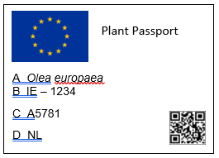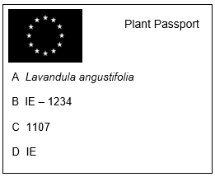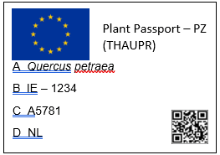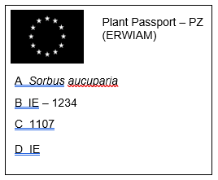Updated plant passport regulations from December 14

New EU plant health regulations coming into effect December 14 will make it a requirement for all plants for planting to be accompanied with a plant passport.
4 December 2019
From December 14, all plants for planting will require a plant passport when moved between professional operator to professional operator and will have a common format throughout the EU.
All distant sales operators must be registered with the Department of Agriculture, Food and the Marine (DAFM).
Plant passports are not required for plants, plant products, and other objects supplied directly to final users but under the new Plant Health Regulation, protected zones’ host plants for planting must have a plant passport to the end user but this may be subject to exemptions should the EU Commission decide.
Format of the plant passport
Plant passports must be visible, legible, and be clearly distinguishable from any other information or label.
Due to the differences in size and characteristics of the plant material for which a plant passport is required, a certain degree of flexibility is ensured as regards the format style and size of the plant passport.
There are various plant passport types available, which allow for these differences. These types do not specifically require a particular size for the plant passport or specify the use of a border line, the proportion, and the fonts used.
The elements of the plant passport should be arranged within a rectangular or square shape, and should be clearly separated from any other written or pictorial matter by a border line or otherwise. It is important to enhance the visibility of plant passports and their distinctiveness from any other information or label.
Plant passports issued on or after the December 14, 2019, must comply with the new format whereas passports issued before December 14, 2019, should remain valid until December 14, 2023.
Types of plant passports
The plant passport for movement within the EU territory shall contain the following elements:
- The words “Plant Passport” in its upper right-hand corner.
- The flag of the Union in its upper left-hand corner, printed in colour or in black and white.
- The letter “A”, followed by the botanical name of the plant(s) species or taxon concerned, in the case of plants and plant products, or, where appropriate, the name of the object concerned, and, optionally, the name of the variety.
- The letter “B”, followed by subsequently the two-letter code for the Member State (IE for Ireland), in which the professional operator issuing the plant passport is registered, a hyphen, and the registration number of the professional operator. For example, a professional operator registered in Ireland would record their registration number as: “B IE – 1234”.
- The letter “C”, followed by the traceability code of the plant, plant product, or the other object concerned.
- The letter “D”, where applicable followed by:
- The name of the third country of origin, or of the Member State of origin.
The traceability code may also be supplemented by a reference to a unique traceability barcode, hologram, chip, or other data carrier, present on the trade unit.
Examples of plant passports for non-protected zones
Plant passports for movement into and within protected zones
The plant passport for movement into and within protected zones shall contain the following elements:
- The words “Plant Passport — PZ” in its upper right-hand corner, in one of the official languages of the Union and in English, if different, separated by a slash.
- Immediately underneath those words, the scientific name(s) or the code(s) of the respective protected zone quarantine pest(s);
- The flag of the Union in its upper left-hand corner, printed in colour or in black and white.
- The letter “A”, followed by the botanical name of the plant species or taxon concerned, in the case of plants and plant products, or, where appropriate, the name of the object concerned and, optionally, the name of the variety.
- The letter “B”, followed by subsequently the two-letter code for the Member State (IE for Ireland), in which the professional operator issuing the plant passport is registered, a hyphen and the registration number of the professional operator. For example, a professional operator registered in Ireland would record their registration number as: “B IE – 1234”.
- The letter “C”, followed by the traceability code of the plant, plant product, or the other object concerned.
- The letter “D”, where applicable followed by:
- The name of the third country of origin or, the two letter code of the Member State of origin and, in the case of replacement of the plant passport, the registration number of the professional operator concerned who issued the initial plant passport or for whom the initial plant passport was issued by the competent authority.
The traceability code may also be supplemented by a reference to a unique traceability barcode, hologram, chip or other data carrier, present on the trade unit.
Examples of plant passports for protected zones
You can view DAFM’s presentation from the Teagasc nursery stock conference which took place on October 23 here. You can also view a video below where Dónall Flanangan, nursery stock/ornamentals specialised advisor with Teagasc discusses the new regulations with Oliver McEvoy of DAFM. For more information on the regulations coming December 14, see here.



 Print
Print













Fans 0
Followers